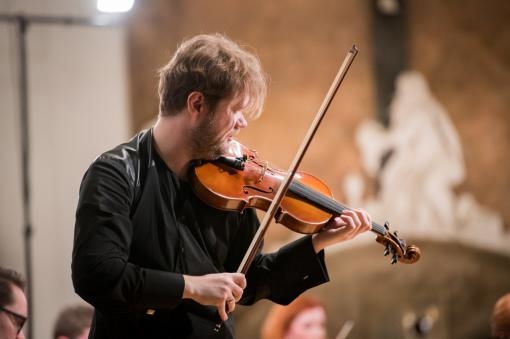Every now and then works appear on a concert that the listeners have not had a chance to appreciate before. In most cases these premieres serve to spice up the otherwise standard repertoire of a concert. Whether it is a brand new piece or a modern premiere resulting from long hours of research in the archives, it normally takes place alongside a long-term classic. For example if a reconstructed symphony by an unknown classical period composer is to be performed then it is almost a certainty that with it we will hear Mozart, Beethoven or Haydn. The programme for the concert by Brno’s Ensemble Opera Diversa with the violin virtuoso Milan Paľa, with which the orchestra opened their concert cycle Slovakia in Brno, was however made up only of premieres of contemporary music.
It is a sad irony that although concerts presenting contemporary works should enjoy the greatest esteem, in most cases the organisers struggle with low attendance and lack of interest. Fortunately the Concerto for Milanolo, as Ensemble Opera Diversa called this musical evening, did not have a problem with a lack of listeners. A great attraction for much of the audience is probably the figure of Milan Paľa, who has already performed with the orchestra several times. In this case however the violinist not only interpreted each of the works but they were written for him, or for his violin, since his five-stringed violin is called the Milanolo.
The concert opened with the piece Struny: steny, zhluky, sny by the composer Adrián Demoč. Although the orchestra under Marián Lejava gave an excellent performance, in comparison with the others it was the weakest work in the concert. Not even Milan Paľa’s precise effort could raise the result to the level of the remaining three pieces. After a while the monotonous barking of the orchestra resembled a degenerate version of Psycho by Bernard Herrmann. The expressively brutal strokes of the strings could have carried it dramatically, if they contained at least traces of development. Even in its most lyrical parts the composition did not rise above grey banality. The sterile melody of the violin was carried impassively over the colourful stain of the orchestra. This compositional principle is found quite frequently in the music of the 20th and 21st centuries, and although it often acts as an element of stagnation, it can serve to present the composer’s colourful thoughts. In the case of the composition by Adriána Demoč unusually colourful stains did not appear. Despite this there were some good ideas in the piece. The most impressive may be considered to be the steadily more urgent and rapid sequence of aggressive moves from the strings. With the almost instant rhythmic and melodic imitation, which resounded from all corners of the orchestra, the musical tension grew almost exponentially. And in these moments, the work by Adrián Demoč was at its strongest.
Struny: steny, zhluky, sny was followed by the composition Alef by Pascal Manolios. A work with broader melodic and rhythmic ideas. Frequent changes in parts, jumps from the lowest to highest regions, dramatic shifts in rhythms or even of a twisted and sinister dance-like character – all these aspects, although packaged in thoroughly modern language, the composer has incorporated into the work that is internally consisted and accessible. The piece benefits also from a development in mood which moves from aggression to dark sorrow. Conversely the sudden growling bass represents and element from the opposite camp in modern music. Perhaps only the final coda to the excellent gradations, which could have calmly finished the piece, was somewhat superfluous.
The second half of the concert opened with the work EmFraGre by Jevgenij Iršai. While Manolis’ composition built most of its musical effects on sharp contrasts and exposed drama, the work by Jevgenij Iršai gave the largest space primarily to the lyrical solo violin. For the vast majority of the time the sound of the orchestra was cultivated and full. The last piece Omayra by the composer and conductor of the concert Marián Lejava followed in a similar spirit. Here, however, in addition to the cultivation of the sound there were somewhat flattened and contrasting transitions between musical passages. After the dramatic entry the music flowed from one extreme to another, rather than forcibly place musical parts against each other. Of course I am not saying that the piece lacked its dramatic moments, but rather that it took a slightly different approach to them.
The concert by Ensemble Opera Diversa offered works by contemporary composers in a quality and energetic interpretation. From a technical perspective all the works represented a challenge both for the orchestra and for the soloist Milan Paľa. The violinist managed even the most demanding passages with enthusiasm from within illuminating with the quality of his interpretation even the gentlest and most ethereal passages. If you wanted to get to know contemporary Slovak music or music about Slovakia, you could not have come to a better place.
































No comment added yet..